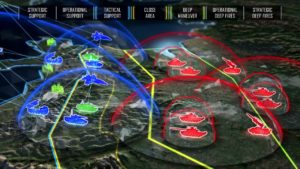The Army’s tactical network modernization team will test range extension for connectivity and the potential for leveraging the network for artificial intelligence-enabled target recognition at the service’s Project Convergence demonstration this fall.
Project Convergence is the Army’s first event this fall to bring together the Army’s modernization-focused Cross Functional Teams (CFT) to understand how its future platforms, from long-range fires to air and missile defense assets, could form a new “sensor-to-shooter” network.
“There will be participation from multiple cross-functional teams. And this is really a campaign of learning. We’re in a phase where we’re pulling everybody together as we move on a path toward multi-domain dominance by 2028,” Maj. Gen. Pete Gallagher, director of the Network CFT, told attendees during a Potomac Officers Club online discussion Tuesday. “This Project Convergence exercise is really an important next step in the horizontal integration of our modernization efforts.”
Gallagher said the network modernization team will work across the CFTs to test the limits of the range extension for its new mesh network.
“We’re pushing it to the limits through air-launched effects and connectivity from a variety of platforms. So our mesh network that’s part of our Integrated Tactical Network is really being pushed to the limit for transport,” Gallagher said.
The Network CFT is also planning to understand how new capabilities to modernize the network may factor into AI and machine-learning aided target recognition tools being developed by the Army’s S&T community.
“It’s an initial look at artificial intelligence and machine learning to get help with target recognition and the sensor-to-shooter kill chain,” Gallagher said.
Gen. Mike Murray, head of Army Futures Command, has previously said Project Convergence is aimed at helping the Army understand how to store the massive amount of data collected on the new modernization platforms it will roll out, to include a new air and missile defense command system to precision missiles and robotic vehicles, and how to best distribute that data to the relevant “shooter” (Defense Daily, May 27).